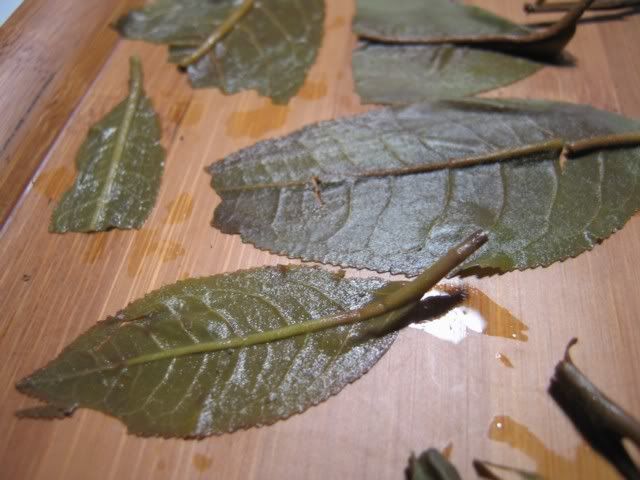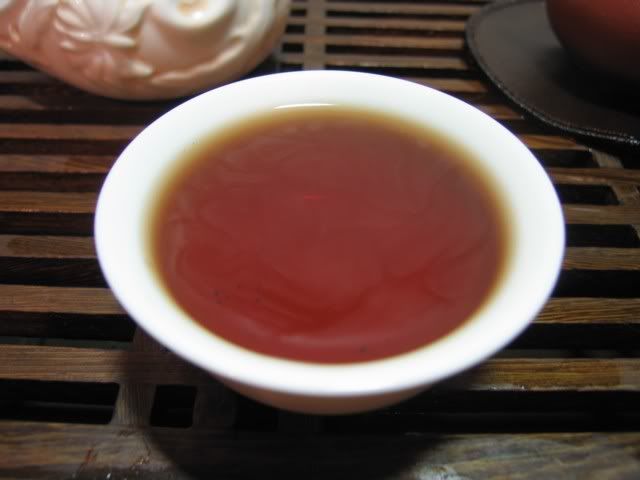and where do I go? I go to Tiffany & Co., of course… (actually, I prefer Cartier)
Anyway, I haven’t even been to the new Tsim Sha Tsui branch of the Best Tea House… and like bearsbearsbears said, it’s quite small. Here’s a shot looking out from the vantage point of the tea drinker/brewer

But believe it or not… it’s actually bigger, physically speaking, than the older branch. The older branch, however, was square, so even though it’s physically smaller, sitting in it feels better.
When I got there after lunch, there were already two older tea drinkers there. They were all getting ready to taste another tea (obviously much has happened already before I arrived). Tiffany was making the tea…. with two gaiwans. Here are the contents:

They are two “thousand taels tea”. The one on the left is an offering of the Best Tea House, whereas the one on the right is brought by one of the drinkers who were there. Thousand taels tea is basically a heavily compressed stick of tea — a very big stick. It’s usually some 5-6ft long, and the diameter is similar to a regular puerh cake. You can imagine how much tea that is. I believe it’s made with Hunan leaves… and it’s got all sorts of stuff in it.

These are how they are brewed, in the same left right setup. Although the way the tea reflected light makes it seem as though the right side is darker than the left, the reality is that they are very close.
The taste, however, is not. The left is sort of medicinal, but a bit thin. The right has everything the left has, but more, and has also a “chen” taste with a sweetness to it that the left doesn’t. Quite nice. Supposed to be around 50 years old (and in the hands of the tea drinker for 15 years already). I’ve tasted a very young thousand taels tea, and that one tasted very rough and unready for consumption. These are both drinkable, although not at these prices….
Then, we tried a Chaozhou gongfu tea — heavily roasted oolong. We brewed it in a pot — sour. We brewed it in a gaiwan… not sour. Something’s wrong with the pot. The owner (the guy who brought the thousand taels tea) said he’ll have to go home and re-season the pot thoroughly to get rid of the nasty taste.
Then… I brought out the two puerhs I brought (well, I brought more). The first is the Yiwu maocha, and the second is the Yiwu girl cake.
Everybody liked the Yiwu maocha… flavourful, smooth, full bodied. It tasted better than when I brew it, so I thought Tiffany’s tea brewing skills are obviously better than mine, for good reasons. I’m glad it tasted so good.
Then we tried the Yiwu cake…. and something was seriously wrong. It was thin, rough, not fragrant at all. Nobody wanted to drink it after three infusions, and I myself felt uncomfortable with the tea too. Something was wrong, quite wrong.
While we were discussing why this might have been the case, we brewed up a little 88 qingbing (88 raw cake) for taste. I’ve never had it, and neither has the other guy who brought the tea and the pot, so we figured it’s not a bad thing to try.
Boy, was I disappointed. Astronomical price tag aside, the tea is thin, bland, lacking in huigan, etc…. only of middling quality all around, if even, and did I mention it’s expensive?
A shot of the wet leaves

I asked a guy I know on Sanzui who’s also from HK about it… and he said “duh… anything left in the Best Tea House at this point that’s a 88 raw cake is not going to be good”. Good point. The good stuff is long gone — picked out by the people who bought it in bulk, or simply lucky enough to buy early.
Meanwhile, we figured that it was probably a water problem — namely that the water I use in Beijing and the water here are different, with the water here (filtered tap water) being very soft and low in mineral content, while the water I use in Beijing is harder. So, to test, I went out, found the closest 7-eleven I could find (2 minute walk away) and bought a bottle of Volvic for our experiment (my preferred option, Vittel, was not for sale there, and I don’t like Evian).
We mixed the Volvic into one of the water kettles, making it an even mix of the tap water and the Volvic, and the other was just tap water. We brewed the Yiwu girl tea up again after a quick rinse.
The result…. was a flavourful, fragrant tea, much, much smoother, and more full bodied. Closer to what I’ve tasted in Beijing. Not quite the same, mind you, but closer.
We then used the tap water to make another infusion of similar time… thin, rough, just like the first few.
Volvic water again… much better. This time the infusion time was short, and it was even more apparent that the tea OBVIOUSLY improved.
However, I think the maocha tasted better with the tap water. What gives?
We tried this with one other tea. This is a tea brought over by the other guy sitting there today, a Wuliang Shan young cake from 05. We tried it with both waters… and the tea was better with the tap water.
I’ve still got to figure out what it is that makes the Yiwu girl tea better with the high mineral content, while the other two better with the regular tap water. This is a bit of a mystery and needs much, much more experimentation.

































 RSS - Posts
RSS - Posts
I took you at your suggestion and have been reading some of your old post-Covid posts. I haven’t been to…